Today, I’m excited to introduce Lab Rax, my latest 3D-printable project—a fully modular and customizable 10-inch server rack system for homelab enthusiasts. Whether you’re managing Raspberry Pi setups, mini PCs, or networking gear, this rack is designed to keep everything organized, adaptable to your needs, and look great on your desk.
Here’s my video of the build, read on for the write-up;
What You Need To Assemble Your Own Lab Rax
- M6x10mm Button Head Screws (16 Required For Frame + Additional For Racks) – Buy Here
- M6 Brass Inserts (8mm OD, 4mm Length) – Buy Here
Equipment Used
What Makes Lab Rax Special?
Fully 3D Printable
Lab Rax is designed to be completely 3D printable, except for a few fasteners and brass inserts that hold it together. It’s optimised for common 3D printer bed sizes of around 250mm square, meaning you don’t need a large-format printer to produce it. The design also requires minimal support material, just four thin strips on the edge pieces, so there’s very little filament waste and hardly any post-processing needed.

Modular Design
The side panels and posts come in increments from 1U to 5U (5U being the largest that fits a 250mm print bed). You can also combine two sections to create any combination of units up to 10U. You can technically add a second joint and extend the rack beyond 10U, but the strength of the 3D-printed parts becomes an issue when going beyond that with a rack full of equipment.
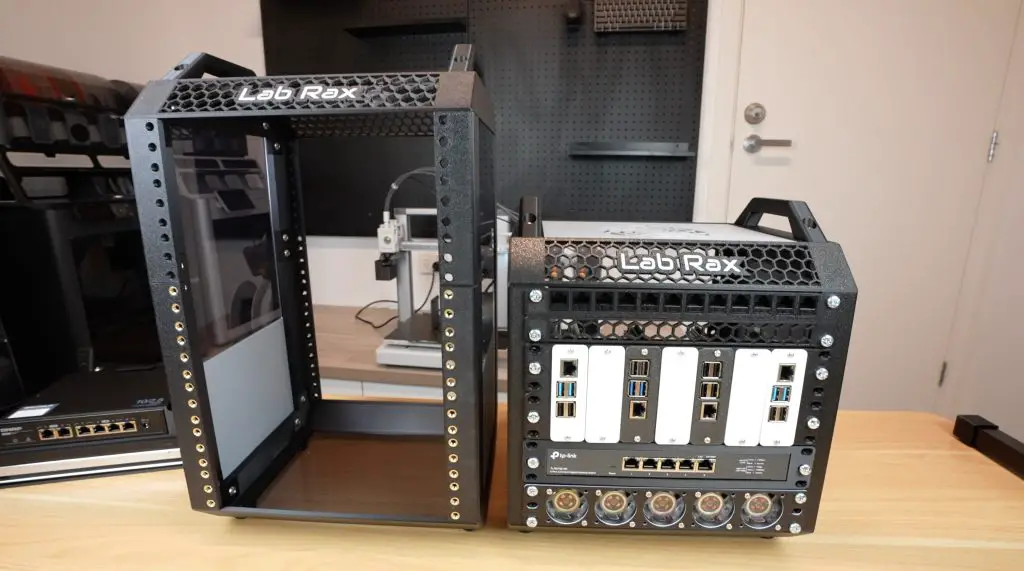
Cost-Effective
Pre-made 10-inch mini racks typically cost between $80 and $150 for the frame alone. In contrast, a 5U Lab Rax frame uses about 580g of filament and an additional 360g for side panels (if you choose to add those). A single 1kg spool of PETG is enough to print out a complete rack and side panels and costs around $15. Add about $6 for the brass inserts and M6 screws, and the total cost is only $21 – nearly a quarter of a commercial version’s price.
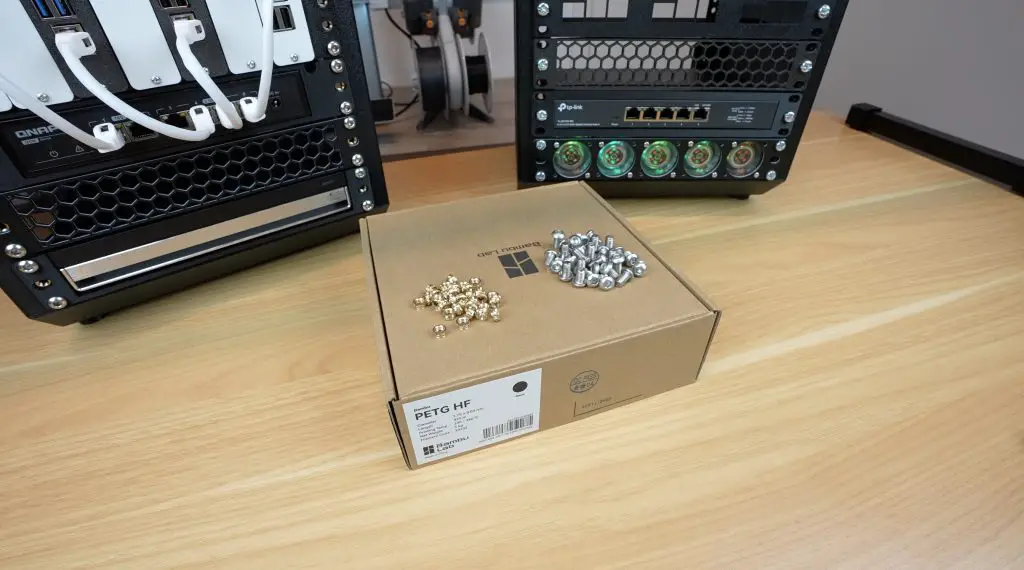
Lab Rax Dimensions & Compatibility
There is no strict standard for 10-inch racks, but Lab Rax follows the most commonly accepted dimensions.

It uses the standard 44.45mm rack unit spacing that is used on larger 19-inch racks, with holes 236.525mm apart and a usable width of 222mm between posts. This makes it compatible with most commercially available 10-inch hardware.
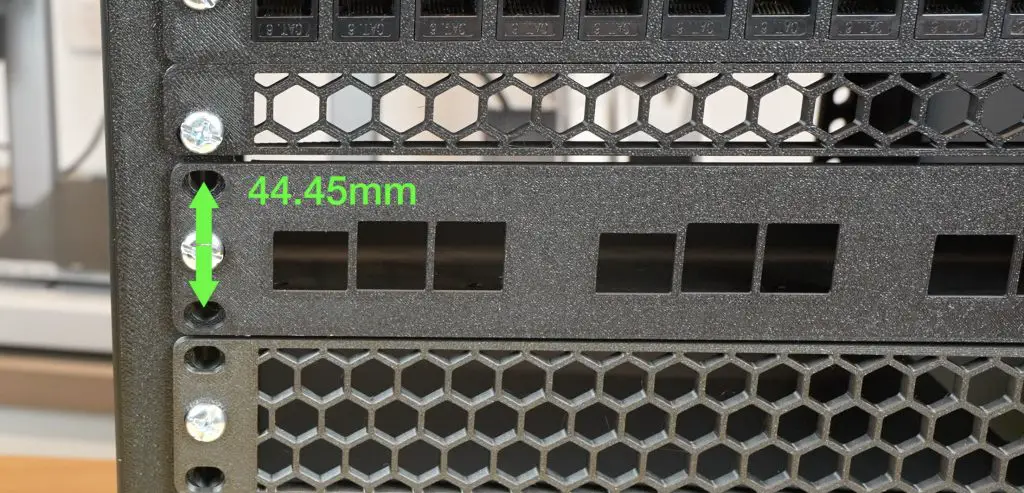
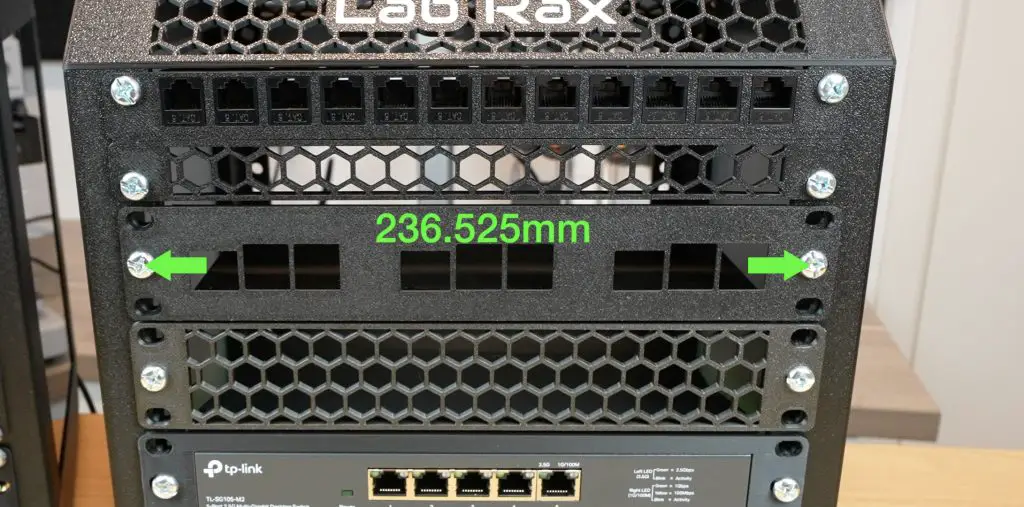
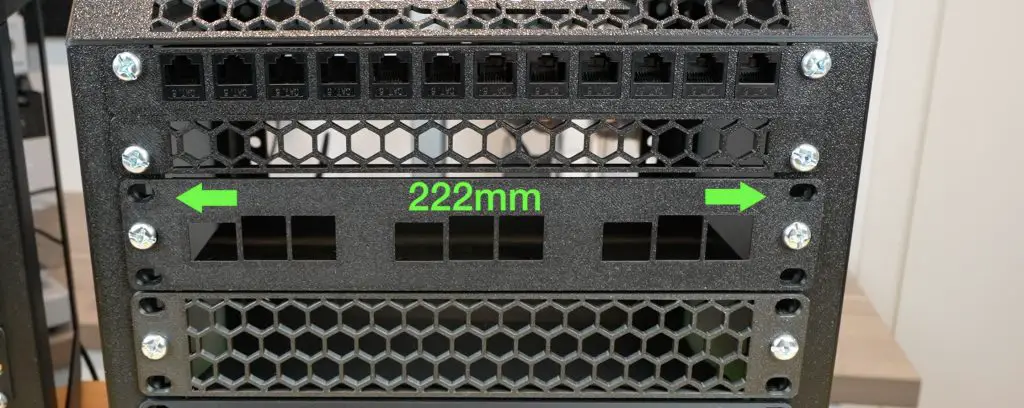
I opted to use M6 screws over 10-32 screws because they are easier to find in Australia, Asia, and Europe. Lab Rax is designed to use M6x10mm screws both for securing the racks and assembling the frame, so you don’t need to buy a bunch of different screw sizes.
If there’s enough interest in this rack system then I’ll release a version using 10-32 screws entirely too.
Customing Lab Rax
One of the best things about Lab Rax is its customizability! Being 3D printed, you can choose from a wide range of filament colors. I’ve used PETG for durability and heat resistance, but PLA works fine for setups with minimal heat, like a few Raspberry Pis and a small networking switch.
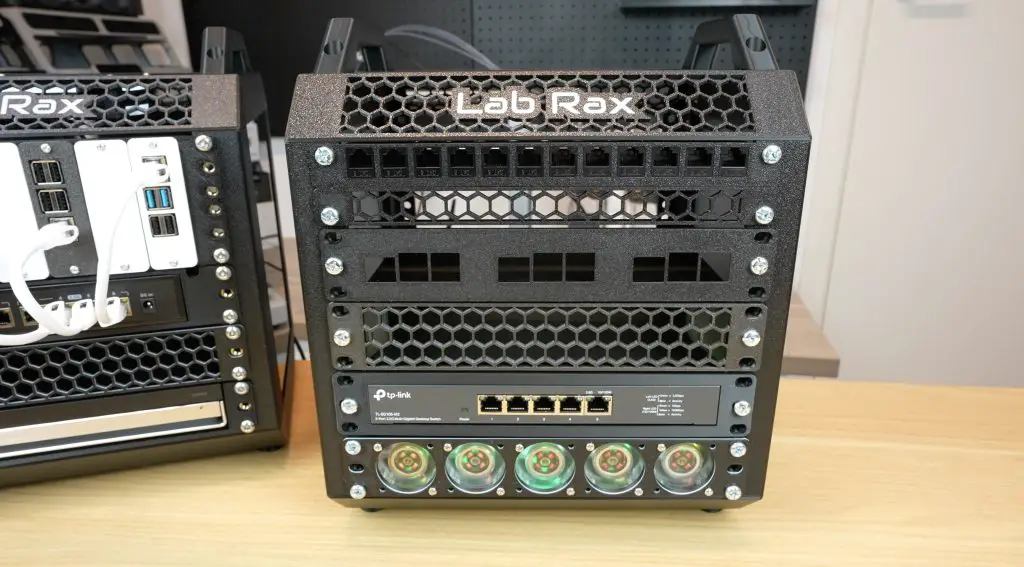
For the two sides, top and bottom panels, you can either 3D print them to match or contrast the frame or cut them from 3mm acrylic or plywood. This allows for clear or tinted window panels or even stylish wooden accents.
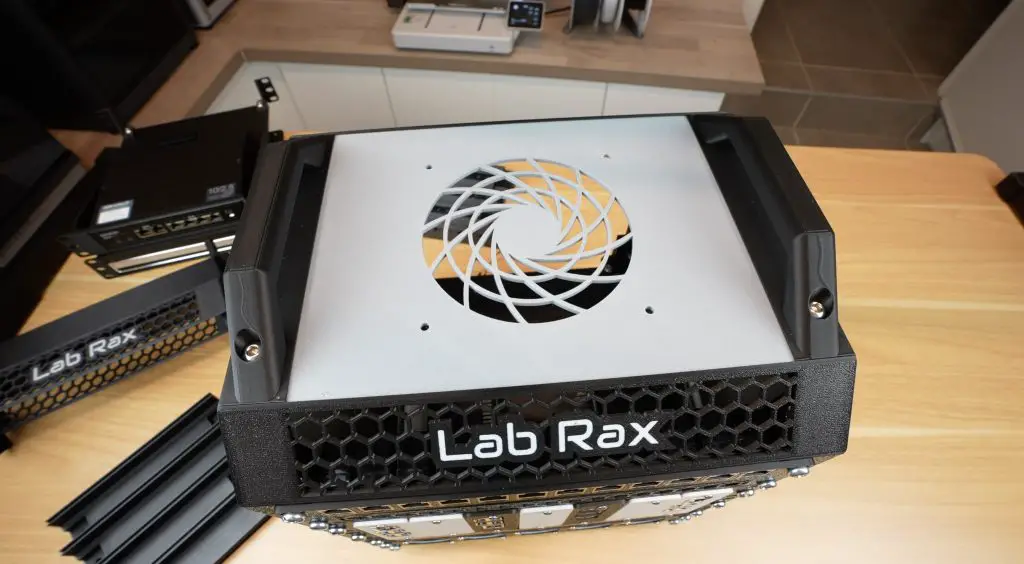
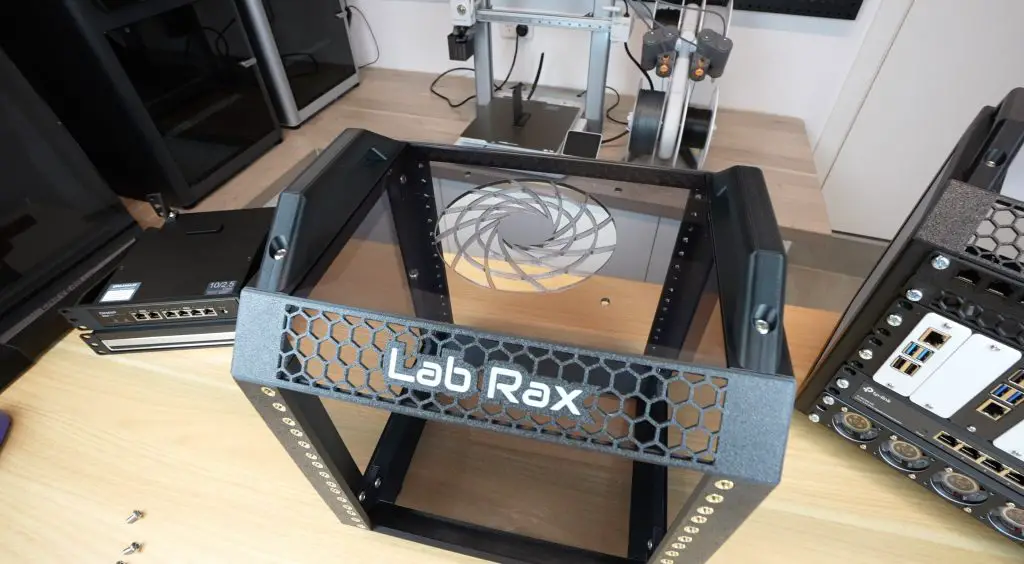
Printing Out The Components
I printed all the parts using the Bambulab A1 Combo, which has a 256mm x 256mm print bed. A full 5U frame and side panels prints across 10 plates in about 26 hours.
Download the additional sizing options
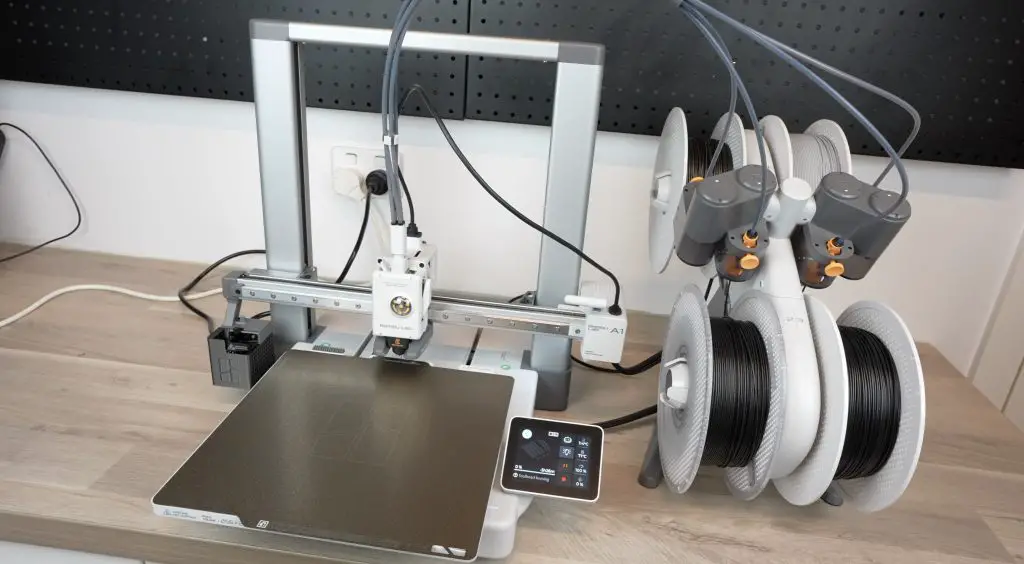
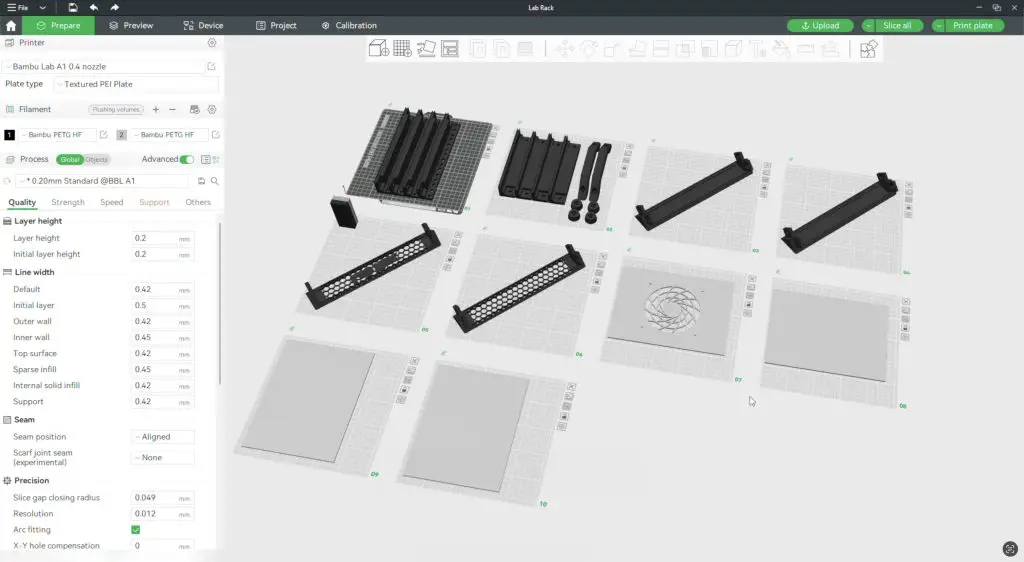
This includes;
- Four vertical posts, printed in a set of four.
- Four edge pieces, two handles, and four feet.
- The feet can also be printed separately in TPU for vibration dampening if you’re running fans or harddrives in your rack.
- Four individual horizontal pieces: These only fit diagonally on the bed, so they need to be printed individually, but they print quite quickly—about 1.5 hours each.
- Four individual panels, a set for the two sides, and a set for the top and bottom. The top can be printed with a fan cutout for a 120mm fan.
The next section has a full bill of materials to ensure that you have the right quantities.
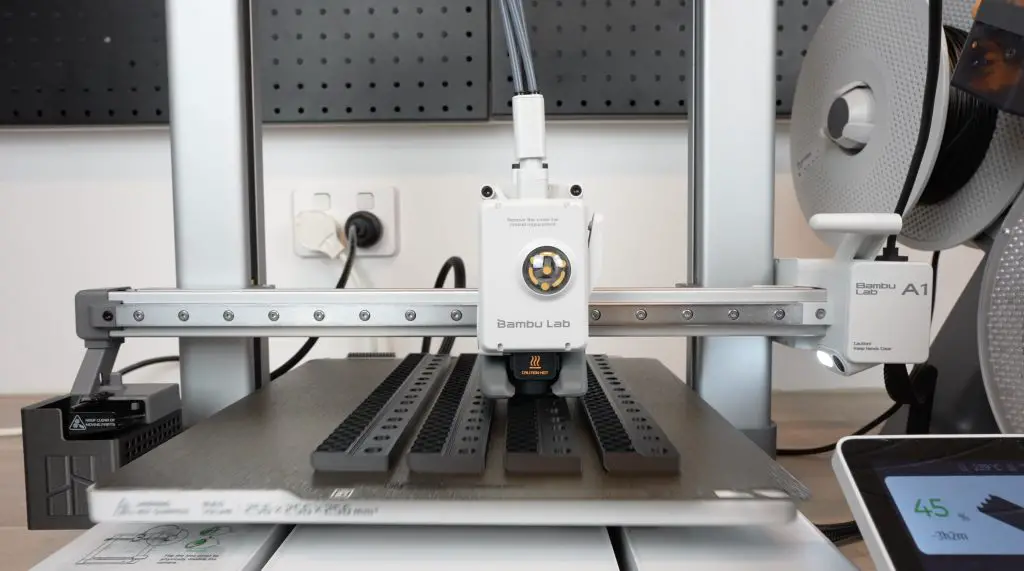
Using the AMS Lite on the A1, you can print in multiple colors to further customise your rack. You can add coloured accent layers, like I’ve done on the vent and fan panels, or add text labels to identify rack components.

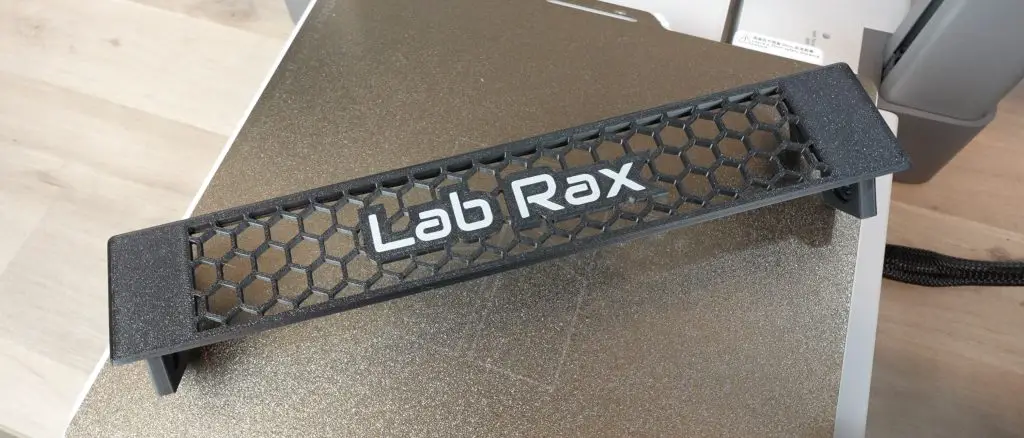
I also tested two styles of side panels: a set of 3D-printed panels in grey on my first rack and a set of laser-cut 3mm tinted acrylic panels on my second rack. I personally prefer the acrylic panels for a sleek look.

Bill of Materials
Now that we’ve had a look at the design and 3D print requirements, here is a full Bill of Materials to help out with ensuring that you have all of the components you need to build your Lab Rax frame;
| Item No | Description | Quantity |
| 1 | M6x10mm Button Head Screw | 24 |
| 2 | M6 Brass Insert (8mm OD, 4mm Length) | 24 |
| 3 | M6 Brass Inserts (To Mount Equipment) | 6 per rack unit (U) |
| 4 | Vertical Post | 4 |
| 5 | Horizontal Edge (Either Solid Or Vented) | 4 |
| 6 | Edge | 4 |
| 7 | Handle | 2 |
| 8 | Foot | 4 |
| 9 | Side Panel | 2 |
| 10 | Top Panel | 1 |
| 11 | Bottom Panel | 1 |
Assembling Lab Rax
Lab Rax is assembled using M6x10mm screws and brass inserts. Each of the four posts and four edge pieces need two brass inserts, which are melted into place using a soldering iron. There are also brass inserts in the top and bottom of the edge pieces to mount the handles and feet onto.
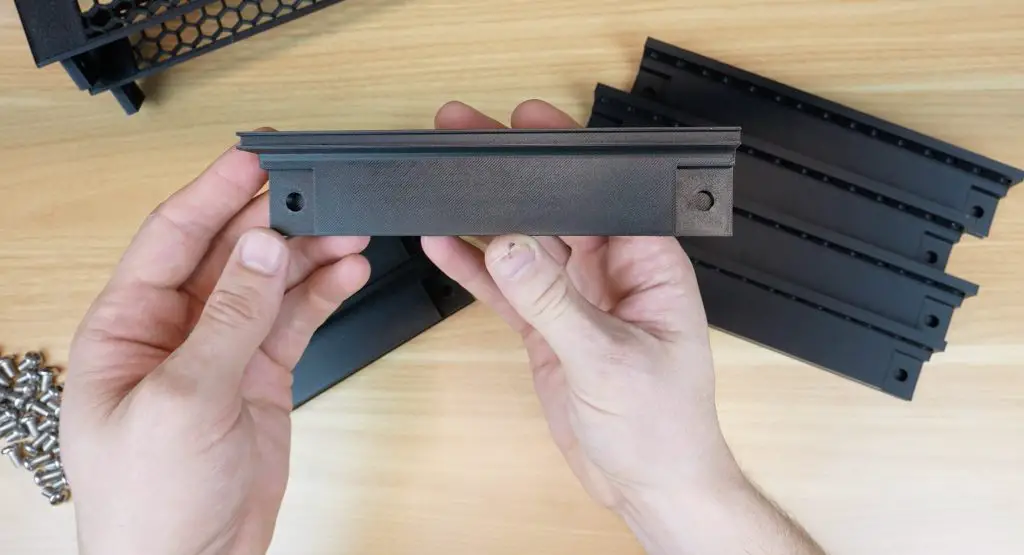
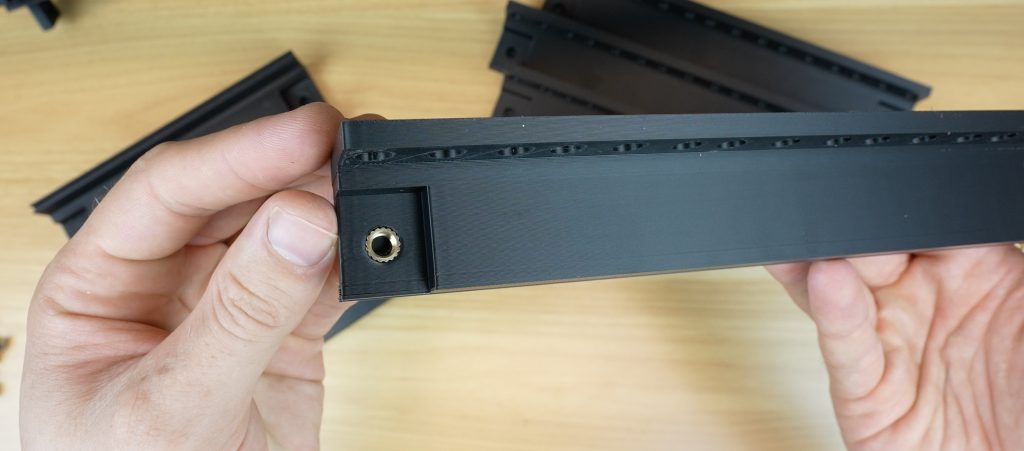
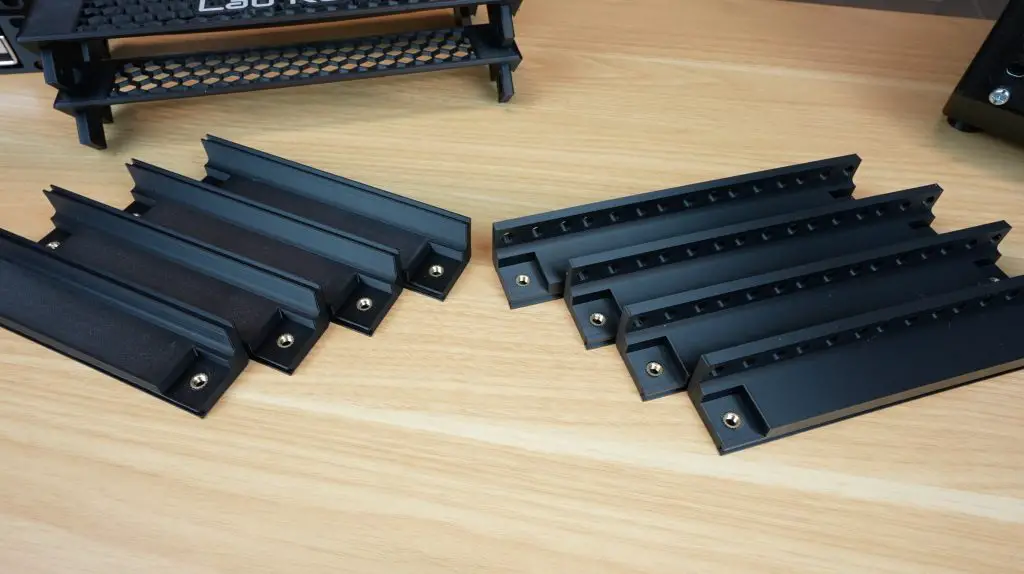
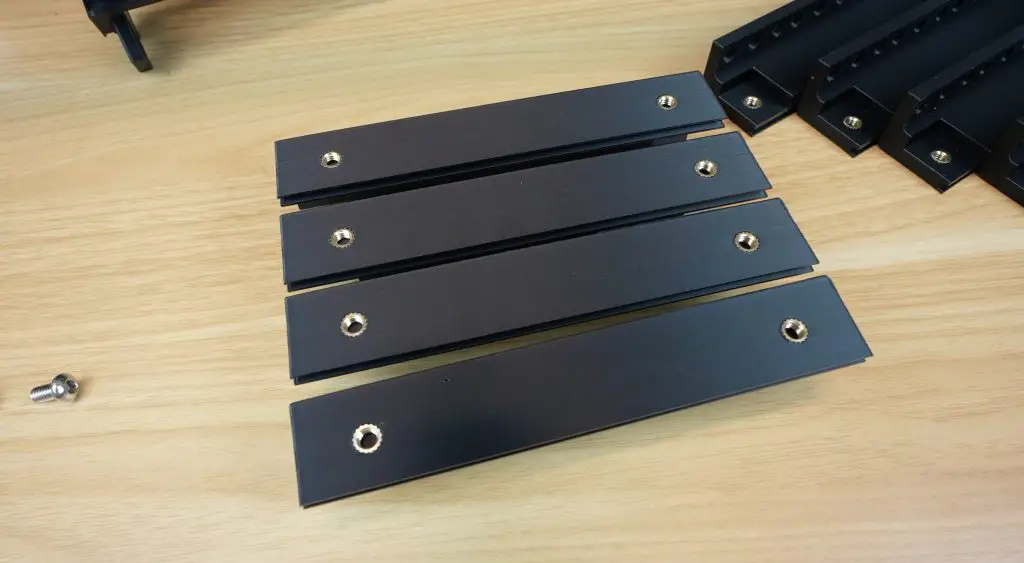
There is the option of either using nuts on the back of the M6 screws to secure the racks or you can add brass inserts to the vertical posts so that they can just be tightened from the front, sort of like a captive nut used on a 19″ rack. I made my first up to use nuts and the second one I’ll make up using brass inserts.
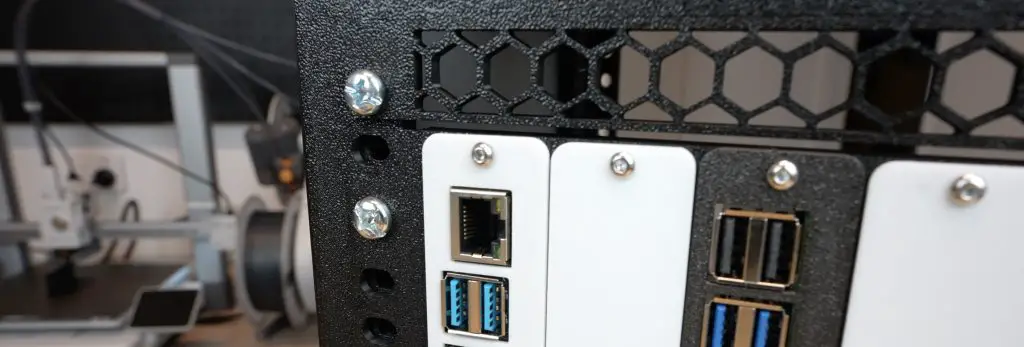
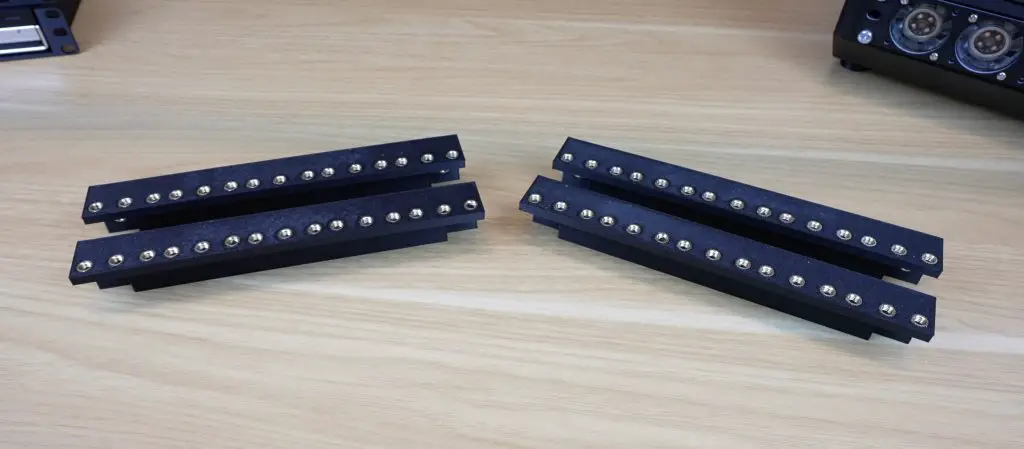
With those melted into place we can start assembling the base.
Two of the side edge pieces and two horizontal pieces are assembled around the 3D printed or acrylic base panel, with a single screw at each joint. I’ve used solid horizontal pieces around the base, and I’ll use the vented ones at the top. These are also interchangeable so you can use any combination you’d prefer.
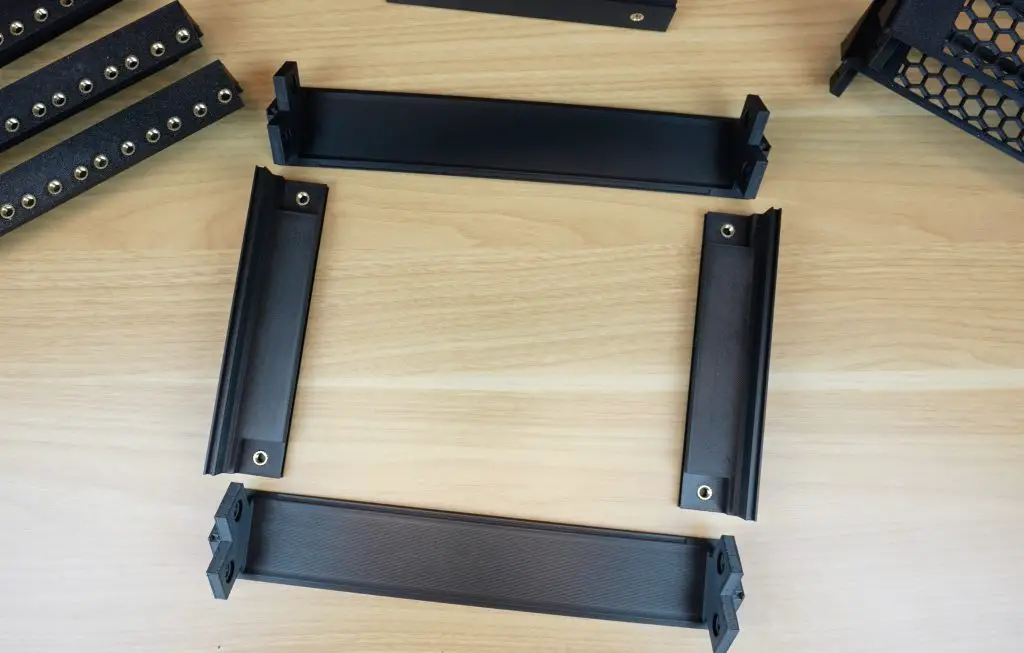
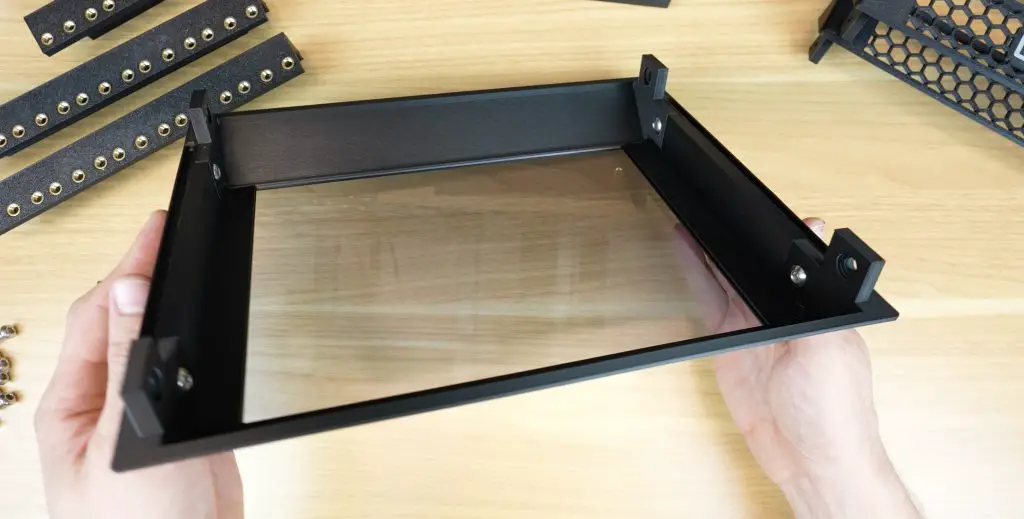
We can then add the four vertical posts, again requiring a single screw at each joint.
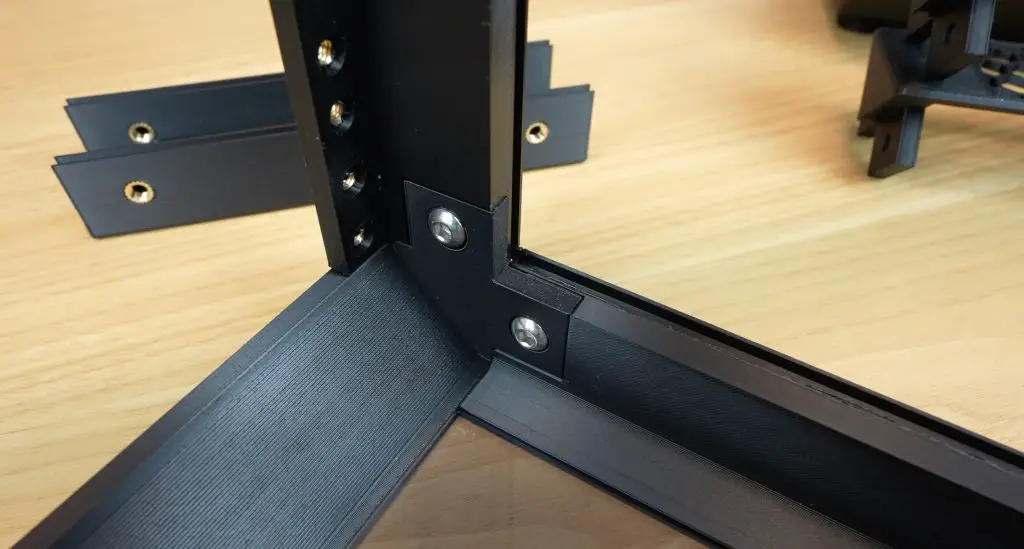
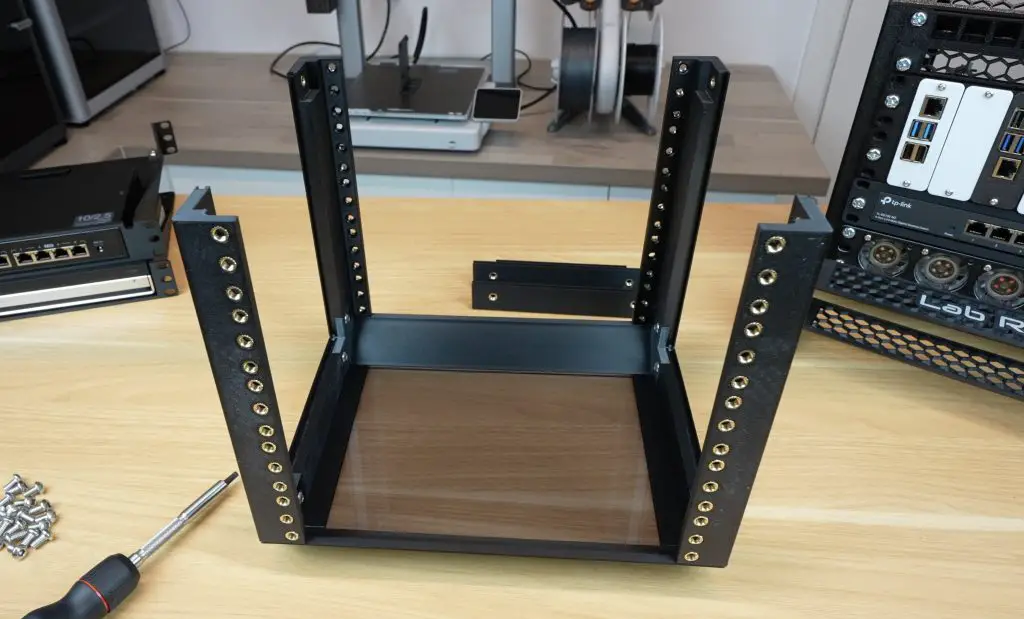
With the vertical posts as guides, we can slide the two 3D printed or acrylic side panels into place.
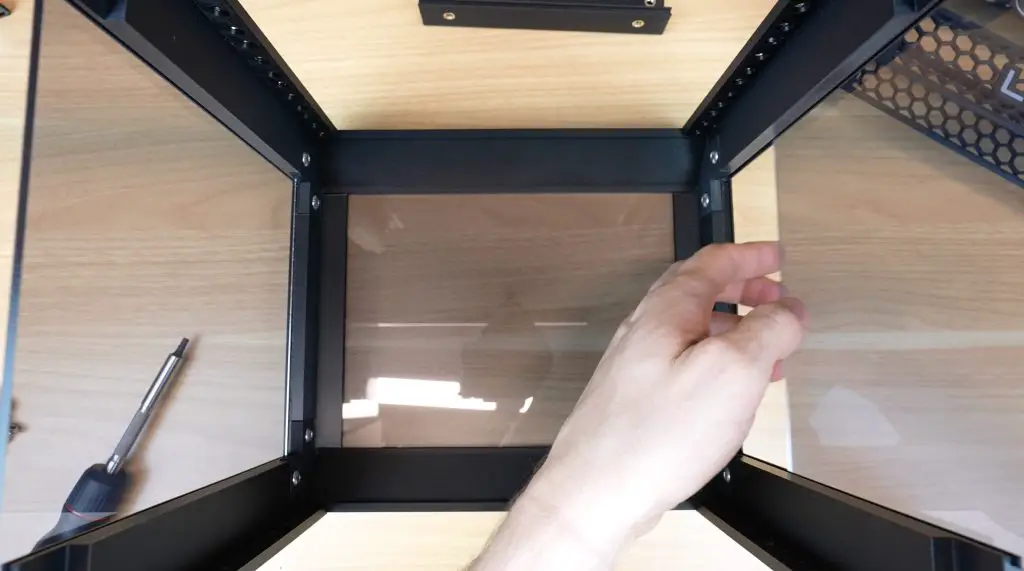
Then add the top two horizontal pieces.
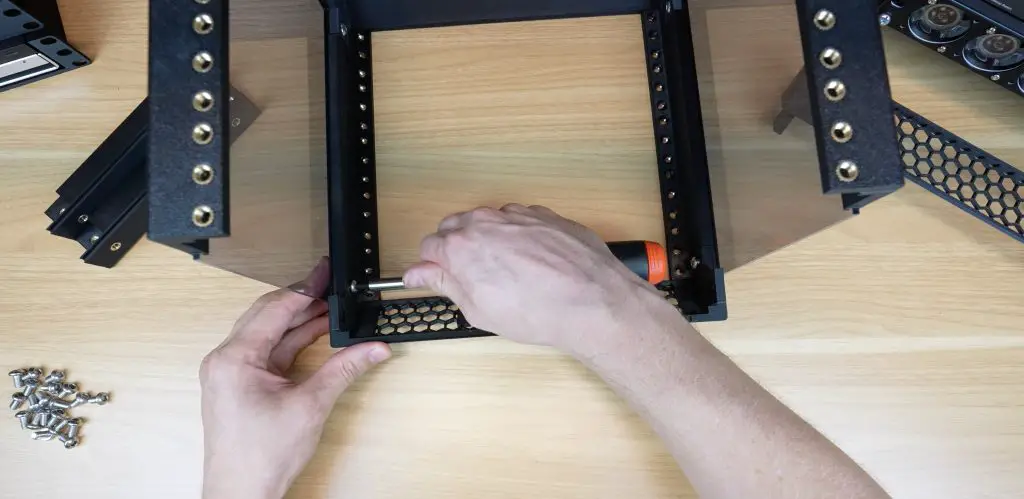
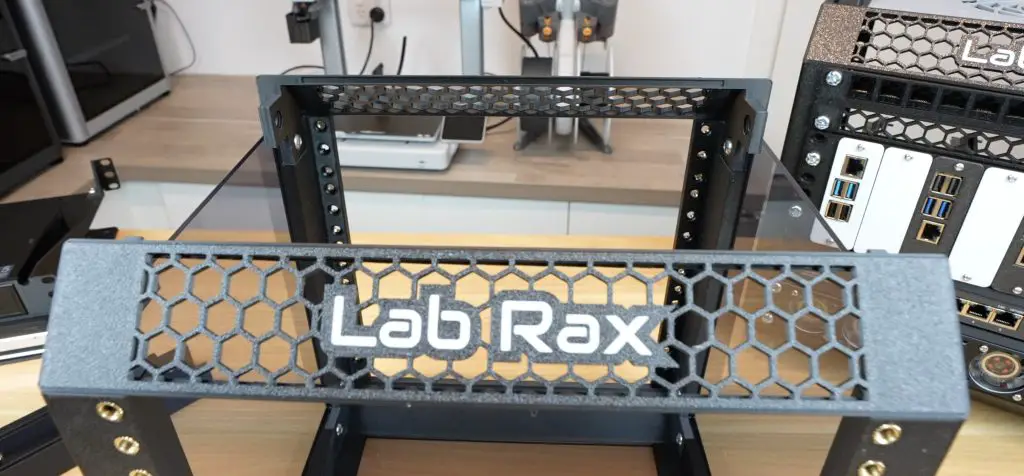
We can add the top panel into the gap and close it up with the last two edge pieces.
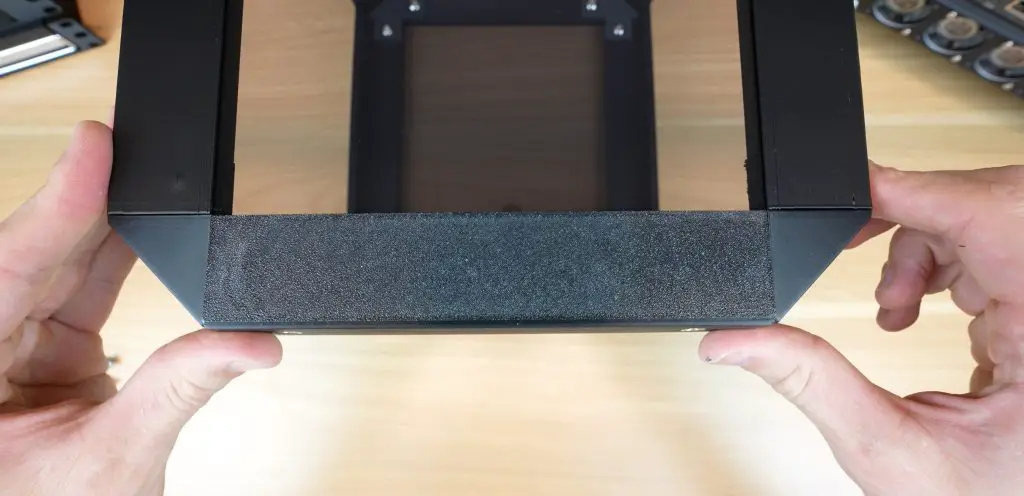
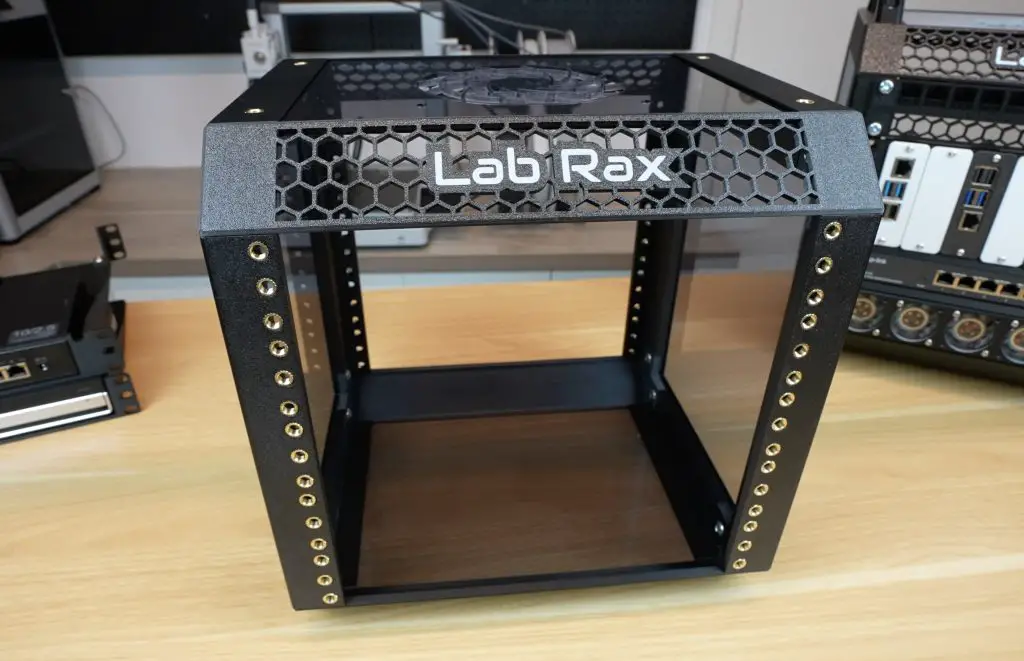
To finish the rack off, we can add the two handles to the top and the four feet to the bottom. These also use the same hole pattern, so you can put handles on the bottom as a stand if you’d like to or feet on the top to stack two racks together.
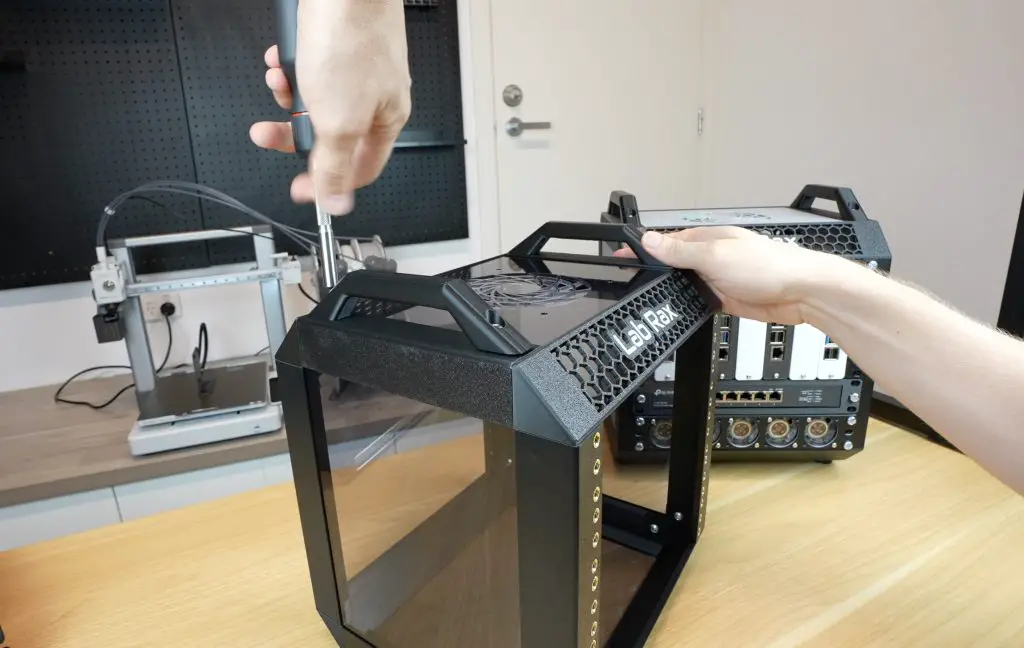
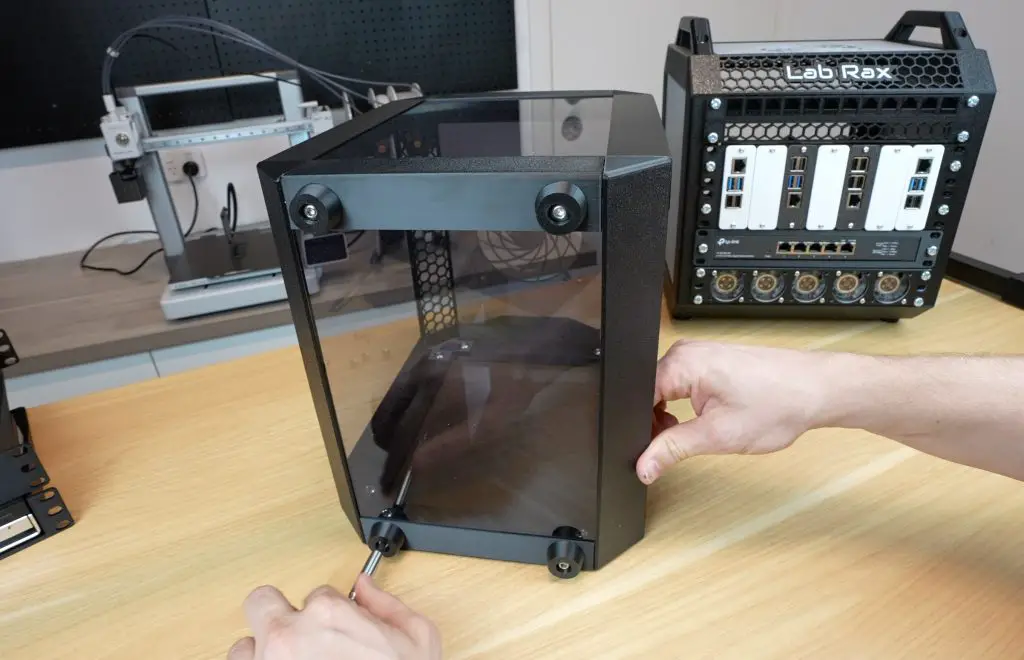
And that’s the basic rack complete.
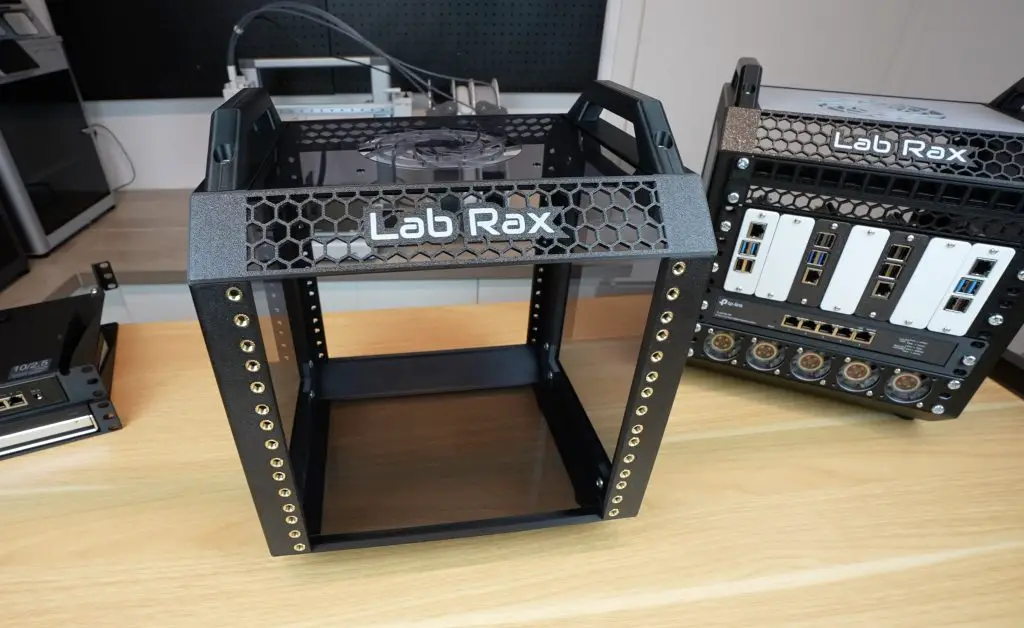
Expanding and Customizing the Rack
I mentioned earlier that you can configure the rack to any number of rack units from 1U to 10U and reuse most of the parts. The only parts that need to be swapped out or added to are the four vertical posts and the two side panels.
Model Files For Extension Side Panels & Joiners
If we reprint the 5U posts as smaller sections, we can make up a 3U rack and if we combine the 3U posts with the 5U posts using the designed joiners then we can make up an 8U rack.
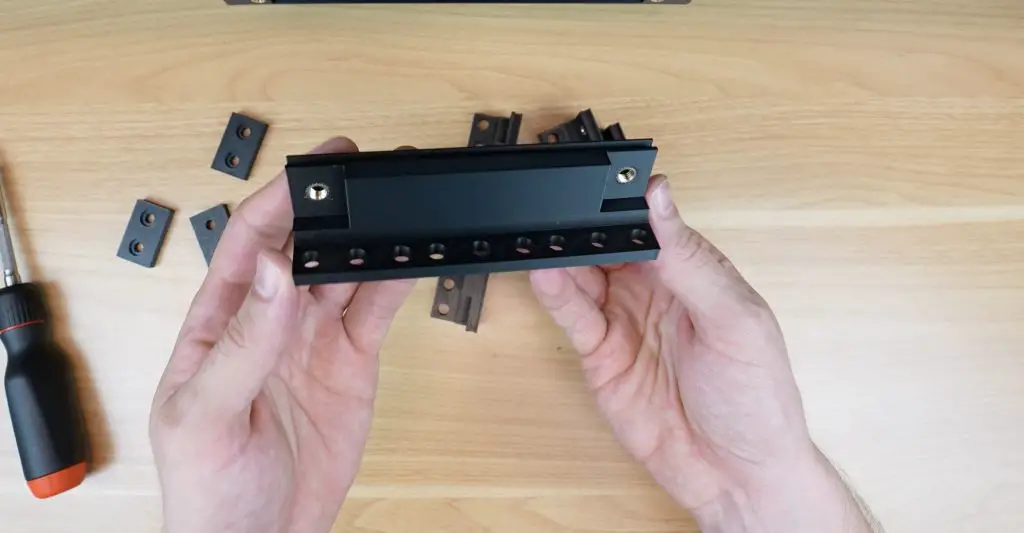
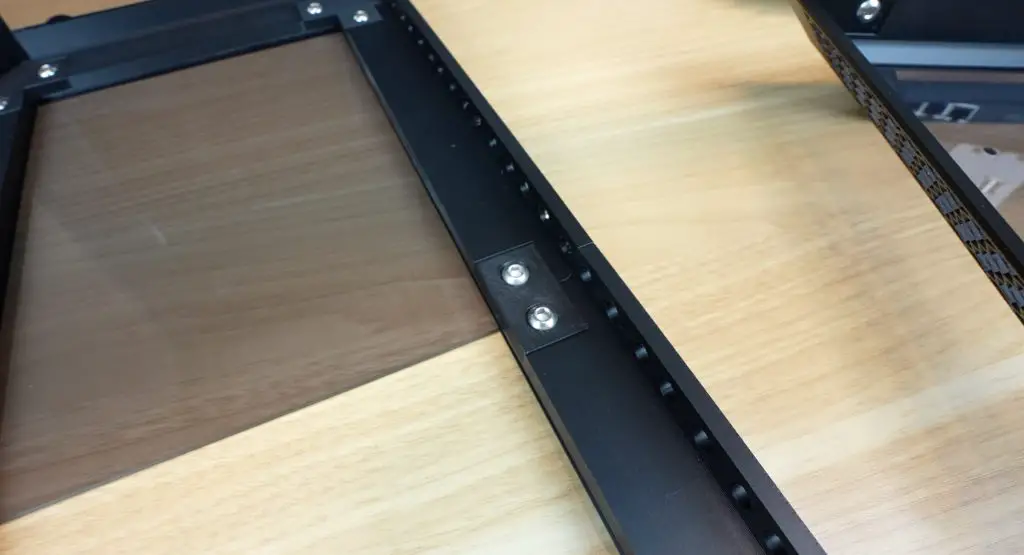
If you aren’t using two of the same length posts then it’s a good idea to put the side panels in the opposite way around to the posts so that the joints don’t line up as this gives it a bit more rigidity.
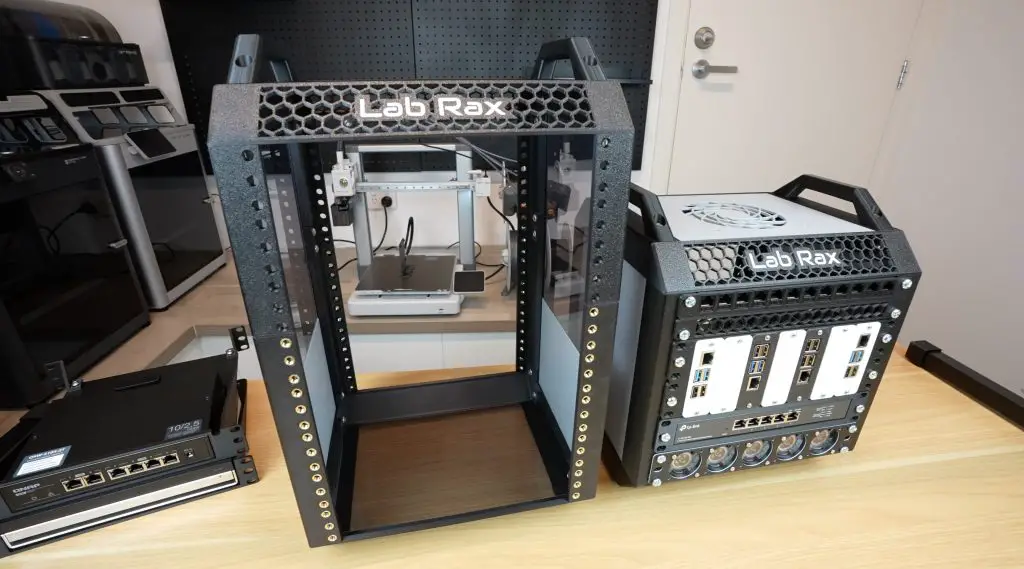
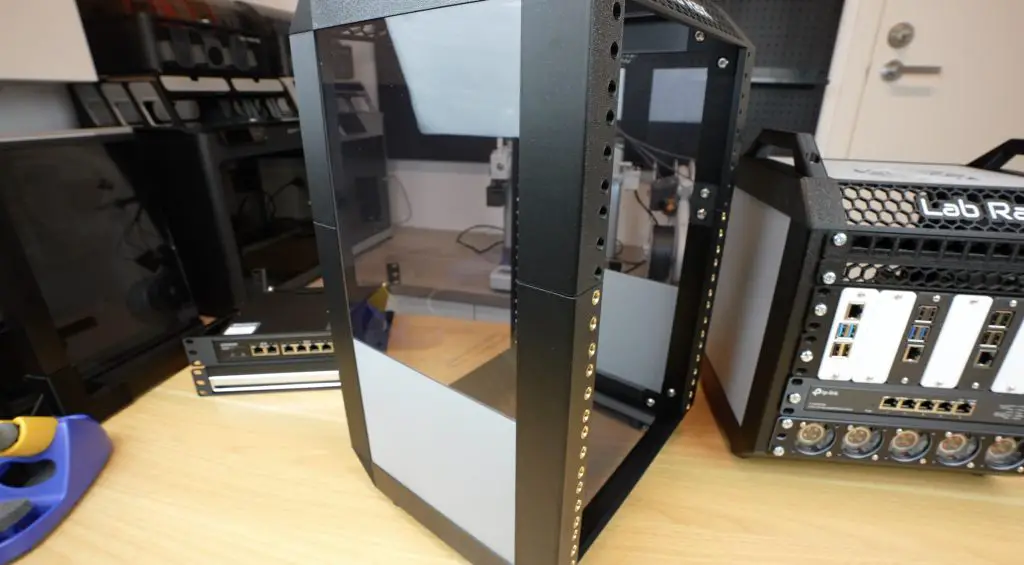
3D Printable 10″ Rack Accessories
To populate the rack, I designed several accessories:
- Blank and Ventilation Panels: Cover unused rack units or allow airflow.
- Fan Panels: Options for 5x40mm fans or 2x80mm fans
- Shelves: Designed for switches, mini PCs, and UPS units
- Patch Panels:
- 1U 12-port Keystone Patch Panel
- 1U D-Type Patch Panel
- Raspberry Pi & SBC Mounts:
- 1U tray for 3 Raspberry Pi 5s
- 2U tray for 7 Raspberry Pis or mixed SBCs
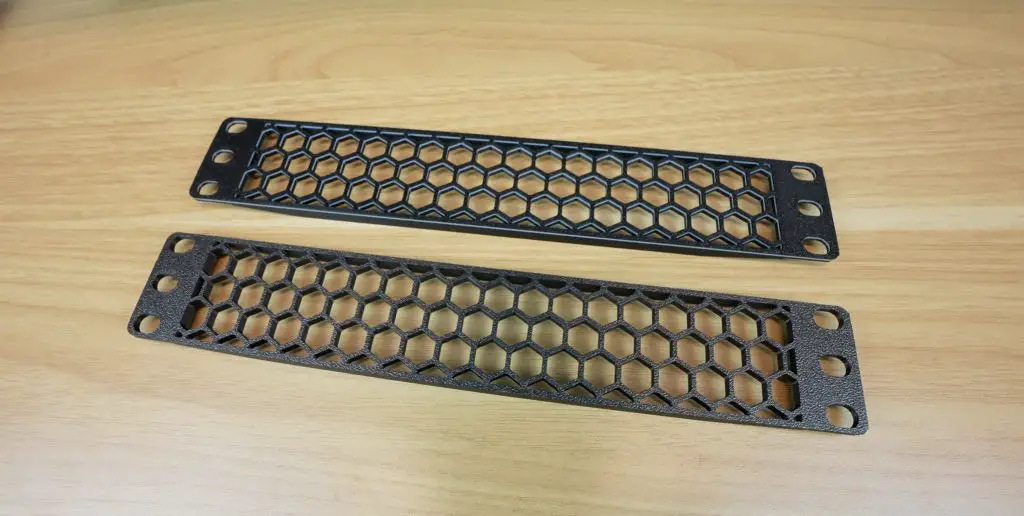
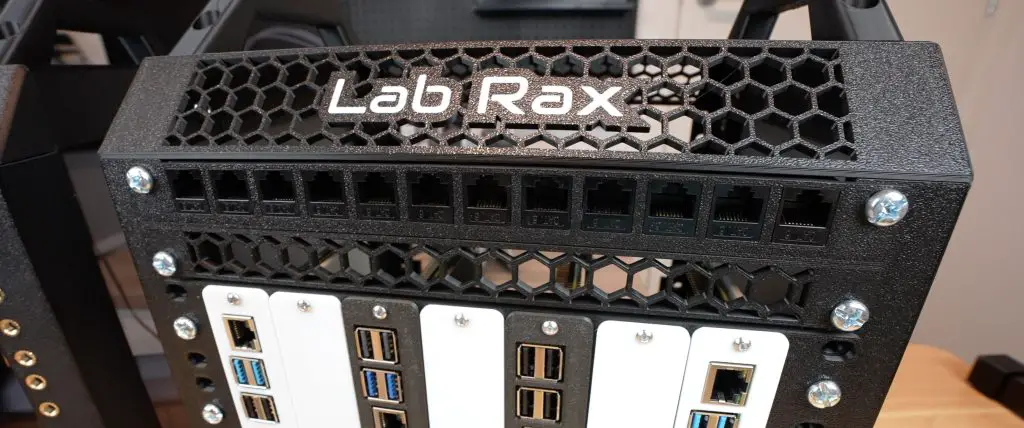
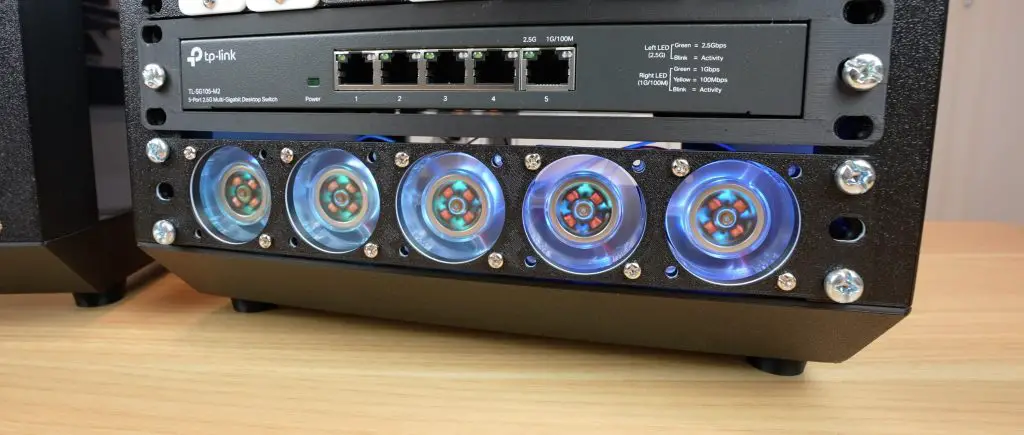
As I find new hardware to add to my rack, I’ll continue to add to the accessory collection. I’m also open to suggestions or request, so leave a comment down below if you have a particular requirement.
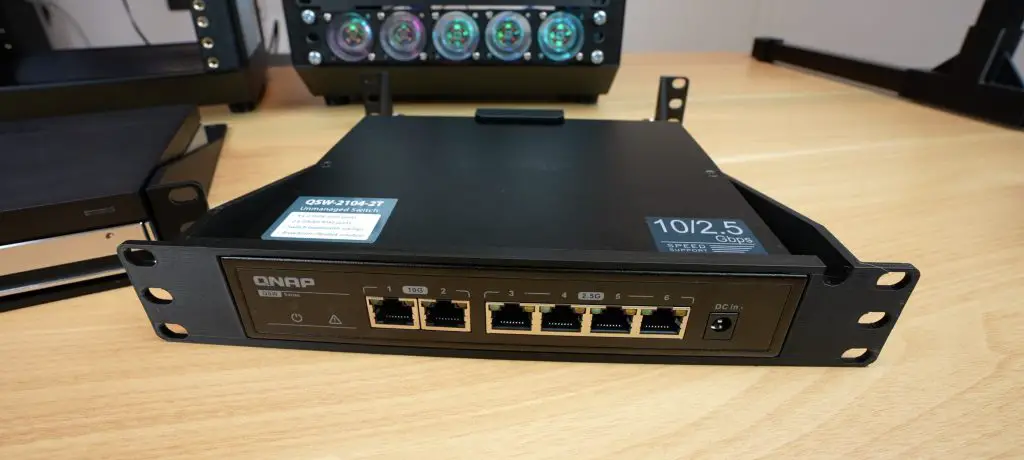
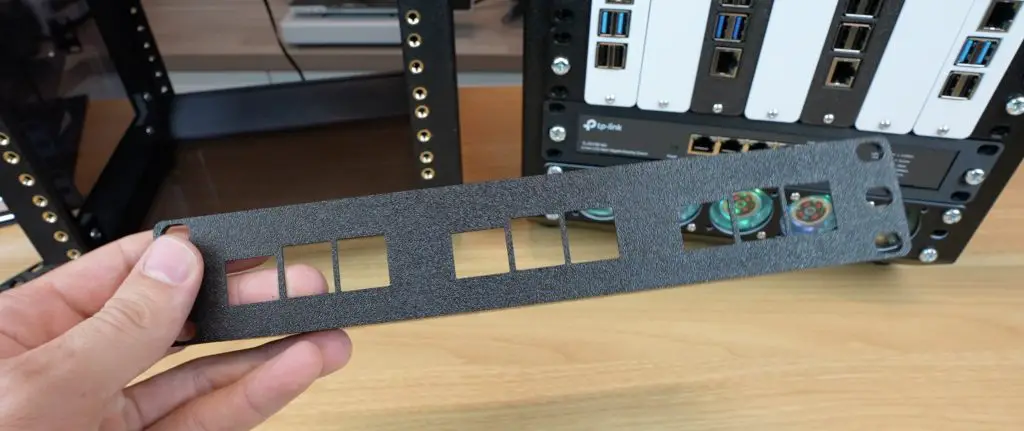
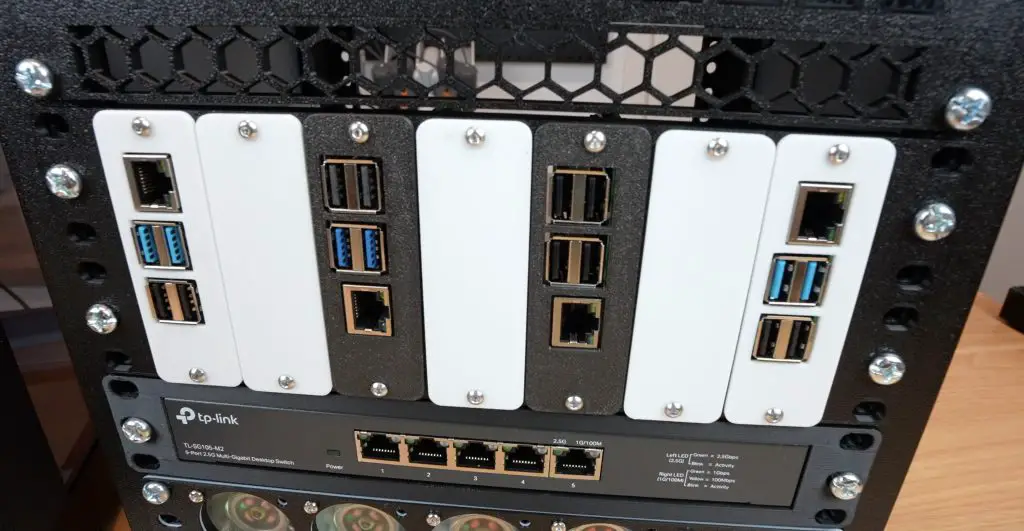
Final Thoughts On My Lab Rax Project
So that’s an overview of my Lab Rax project – a modular, fully 3D printable homelab solution that you can customise to fit your needs. If you’re interested in building one yourself, I’ve put all of the Lab Rax system components and the racks and trays shown in this video up on Makerworld.
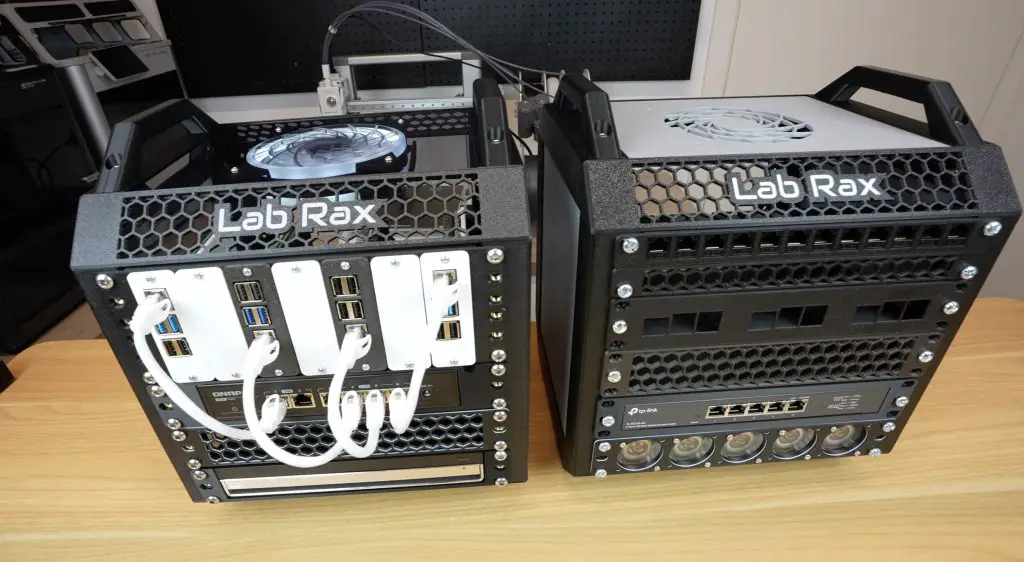
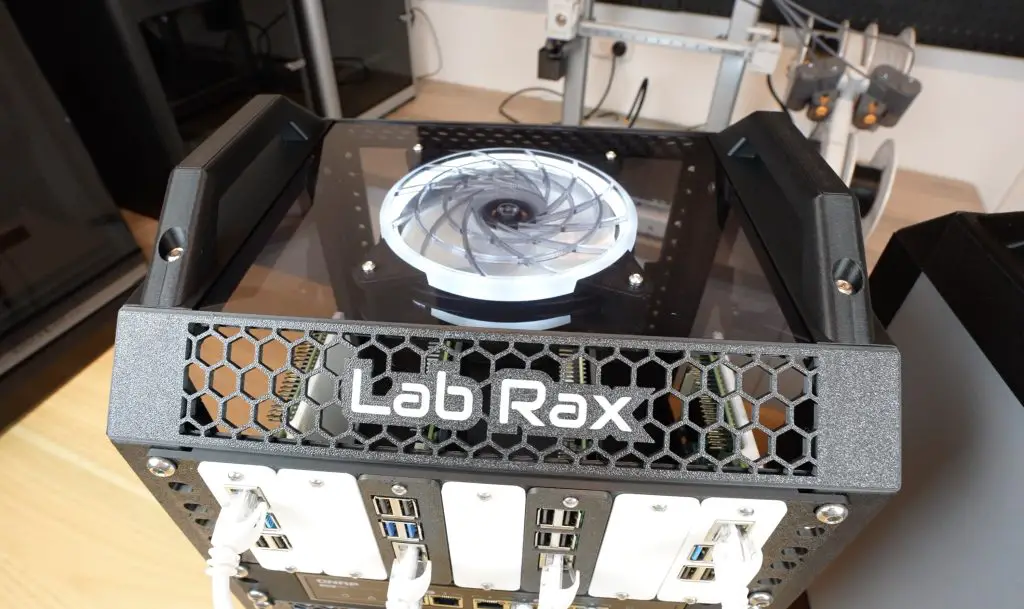
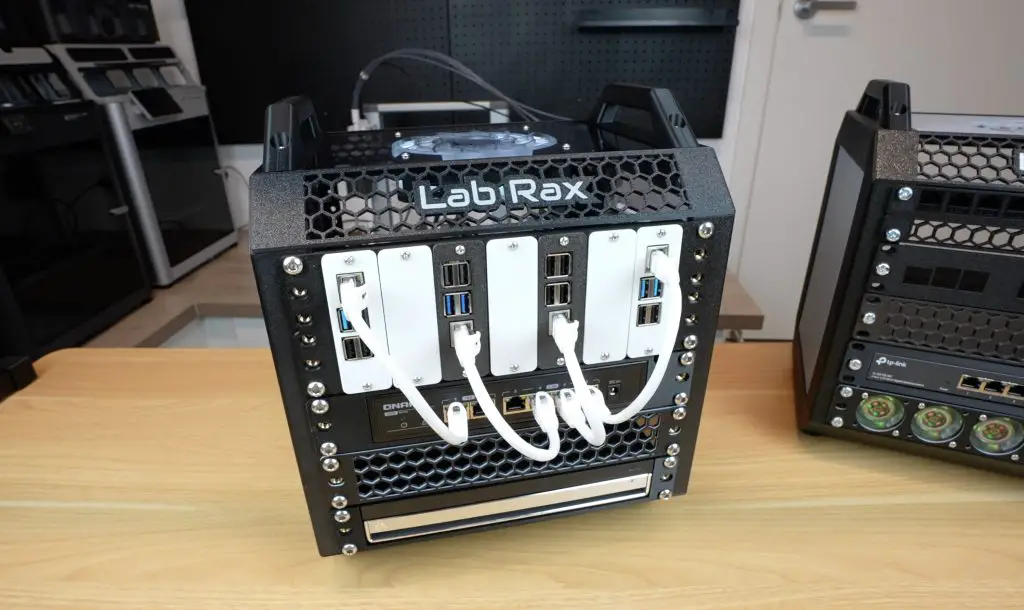
I’d love to hear your feedback! Let me know if there are any features you’d like to see added or if you’d be interested in a 10-32 screw version. And if you build your own, tag me on social media or drop a comment on Makerworld or my blog – I’d love to see your creations!


Hello, wonderful work, thank you for sharing your really interesting work. I wish you a very good day.
Hi Michael, first of all thanks a lot for sharing your work! I have an order in for the brass inserts and screws and my printer is primed to churn this out as soon as it all gets here
Just a note – it would be informational for people considering this project if they had a bill of materials list as well as the final dimensions specified somewhere in the write up. It helps to know at first glance if this can fit on a shelf, and exactly how many inserts and screws to order
But again, great and inspiring work, thanks for sharing!
when you gonna release your
1U tray for 3 Raspberry Pi 5s